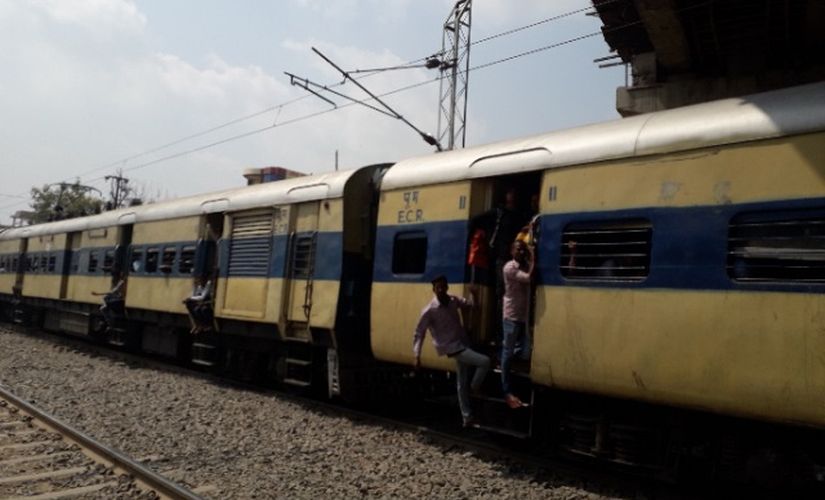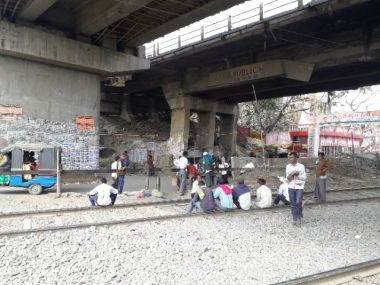Editor’s note: This is part of a multi-article series on the jobs crisis in the three states crucial to Lok Sabha election 2019: Chhattisgarh, Bihar and Uttar Pradesh.
***
Forty-five-year-old Dayanand Kumar boards the train at 3.30 every morning from Jahanabad — 60 kilometers from Patna. He does not buy a ticket. Hanging by the door in a packed coach, he reaches Patna in two hours. The train takes an unusual halt at the railway crossing under the Sipara Bridge in the city before entering the station. And hundreds of passengers de-board from either side. “The motorman knows we travel without ticket,” says Dayanand. “Else, if the train does not show signs of slowing down, someone pulls the chain.” All of those who have de-boarded and assembled under the bridge are hoping to get some work for the day. They live in and around Bihar’s capital city Patna and have been turning up here every morning for years. There are three more such joints in Patna which are informally now known as ’labour chowks’. As the sun makes his lazy journey up the sky, various contractors, or parties, as the workers call it, turn up at these points to solicit daily wage labour. The moment a contractor reaches the spot, labourers frantically encircle him, hoping their desperate faces will be noticed. The contractor proceeds to describe the work he intends to get done, and hires the workers who quote the least amount for their labour. It is just like a bidding process, except it is a sad auction. [caption id=“attachment_6238261” align=“alignnone” width=“825”] Several labourers desperate for jobs make it easier for contractors to exploit them. Gabbar Kumar (left), who has rented a place in Patna at Rs 250 per month because his home is five hours away, says the contractors often make them run for their rightful wages. Image by Parth MN[/caption] Dayanand says he normally got work 15-20 days a month at Rs 250-300 per day, but it reduced since November 2016. “Notebandi wrecked our lives,” he says. “For a year after the decision, we hardly got four-five days of work a month. The contractors did not have money to pay. Most of the informal sector was destroyed.” Both, Prime Minister Narendra Modi and Chief Minister Nitish Kumar are unpopular among the workers, most of whom are either EBCs or belong to the Schedule Castes. If Modi’s demonetisation move, that invalidated 86 percent of India’s currency, disturbed the informal sector, Nitish’s decision to ban sand mining in July 2017 intensified the crisis further. It ruptured the calculations of the state’s workforce, which comprises of the uneducated, semi-educated, and those who are educated but unemployed. [caption id=“attachment_6238281” align=“alignnone” width=“825”]
 In 2017-18, the works under MGNREGA involved almost Rs 30 crore in the district of Patna. But more than Rs 22 crore of payment remains due. The year before that, the total amount involved was over Rs 40 crore, out of which nearly Rs 33 crore has been delayed. Image by Parth MN[/caption] Satish Patel, 40, who has arrived from Masaurhi — 30 kilometers from Patna — says sand mining put an end to all kinds of construction work, which is the major source of employment for daily wage labourers. “There are hardly any industries around,” he says, sitting haplessly beside the railway track. “The work that mostly comes our way is at construction sites. Somebody would be developing a house, or a building might be going up. After the ban on sand mining, the raw material was unavailable to get any kind of work done.” Nitish banned sand mining because of the mafia that operated illegally. But it took him more than six months to regularise it. During that period, the construction work came to a standstill. Contractors say it affected the Pradhan Mantri Awas Yojana, as well, for sand, without which the construction cannot move forward, had become way more expensive. “It was earlier sold at Rs 2,500 for 100 cubic feet, but the price went up to Rs 8,000,” says a contractor. “Worse, the decision came just when we had started to recover from demonetisation.”
In 2017-18, the works under MGNREGA involved almost Rs 30 crore in the district of Patna. But more than Rs 22 crore of payment remains due. The year before that, the total amount involved was over Rs 40 crore, out of which nearly Rs 33 crore has been delayed. Image by Parth MN[/caption] Satish Patel, 40, who has arrived from Masaurhi — 30 kilometers from Patna — says sand mining put an end to all kinds of construction work, which is the major source of employment for daily wage labourers. “There are hardly any industries around,” he says, sitting haplessly beside the railway track. “The work that mostly comes our way is at construction sites. Somebody would be developing a house, or a building might be going up. After the ban on sand mining, the raw material was unavailable to get any kind of work done.” Nitish banned sand mining because of the mafia that operated illegally. But it took him more than six months to regularise it. During that period, the construction work came to a standstill. Contractors say it affected the Pradhan Mantri Awas Yojana, as well, for sand, without which the construction cannot move forward, had become way more expensive. “It was earlier sold at Rs 2,500 for 100 cubic feet, but the price went up to Rs 8,000,” says a contractor. “Worse, the decision came just when we had started to recover from demonetisation.”
The past three years have taken a substantial toll on the labour force of Bihar, a state with third largest population in India. According to the report of Centre for Monitoring India Economy (CMIE) as of December 2018, Bihar’s labour participation rate stood at 38 percent, almost 5 points below the national average, which reflects starkly considering the population of the state. The labour force’s unemployment rate was 8.77 percent, more than 2 points above national average.
Several labourers desperate for jobs make it easier for contractors to exploit them. Gabbar Kumar, who has rented a place in Patna at Rs 250 per month because his home is five hours away, says the contractors often make them run for their rightful wages. “At times, contractors hire us for a period of 10 days or so to finish a project,” he says. “But after the work concludes, they pay half the amount and delay rest of the payment. Sometimes we get it, sometimes we do not.” One of the major reasons behind stark rise in unemployment is the agrarian crisis, where more and more farmers are moving out of their farms and seeking work elsewhere. According to the censuses between 1991 and 2011, nearly 15 million farmers in India have dropped out of the profession at the rate of 2,035 per day. The fact that droughts and floods can happen simultaneously in Bihar, makes the state even more peculiar. Lack of activity in farms also means the landless labourers, who predominantly made their ends meet by working in other people’s lands, have to seek work elsewhere. [caption id=“attachment_6238271” align=“alignnone” width=“825”] One of the major reasons behind stark rise in unemployment is the agrarian crisis, where more and more farmers are moving out of their farms and seeking work elsewhere. Image by Parth MN[/caption] In that context, a scheme like Mahatma Gandhi National Rural Employment Guarantee Act (MGNREGA) was perceived as a crucial intervention to generate rural employment. One of the major objectives of MGNREGA was “enhancing livelihood security in rural areas by providing at least 100 days of guaranteed wage employment in a financial year, to every household whose adult members volunteer to do unskilled manual work”. However, in the district of Patna, from where the workers have turned up under Sipara Bridge, 63,430 households were employed under MGNREGA in 2018-19, out of which 489 completed 100 days or more at work, or 0.77 percent. The year 2017-18 employed fewer households at 57,870, largely due to the ban on sand mining, and a laughable 54 of them completed 100 days of work, which is 0.09 percent. The year before, in 2016-17, 66914 households got employment. 629 of them did 100 days or more. Still, not even 1 percent. In 2017-18, the works under MGNREGA involved almost Rs 30 crore in the district of Patna. But more than Rs 22 crore of payment remains due. The year before that, the total amount involved was over Rs 40 crore, out of which nearly Rs 33 crore has been delayed. DM Diwakar, social scientist based in Patna, says these are consequences of jobless growth, where our growth rate does not match the rate of employment. “Our policies are growth centric, instead of being employment centric,” he says. “India is a federal state, and national policies affect states. The state that has a might of its own would be able to withstand the policies to a certain extent. But a poor state like Bihar would suffer, for it does not have the capacity to execute government schemes on its own.” The outcome of the policy paralysis manifests adequately under the Sipara Bridge every morning. Workers wait until noon before losing hope, and return the next morning with renewed resolve. “It is unlikely to get a day’s job after noon,” says Dayanand, at 11.45 am. “I got work yesterday. Today was not my day.” About five minutes later, a train returning to Jahanabad makes an unofficial halt under the bridge. Dayanand climbs in one of the coaches. Fellow passengers extend a hand to pull him onboard. “The motorman knows,” he says with a wry smile and disappears into the crowd.


)

)
)
)
)
)
)
)
)



